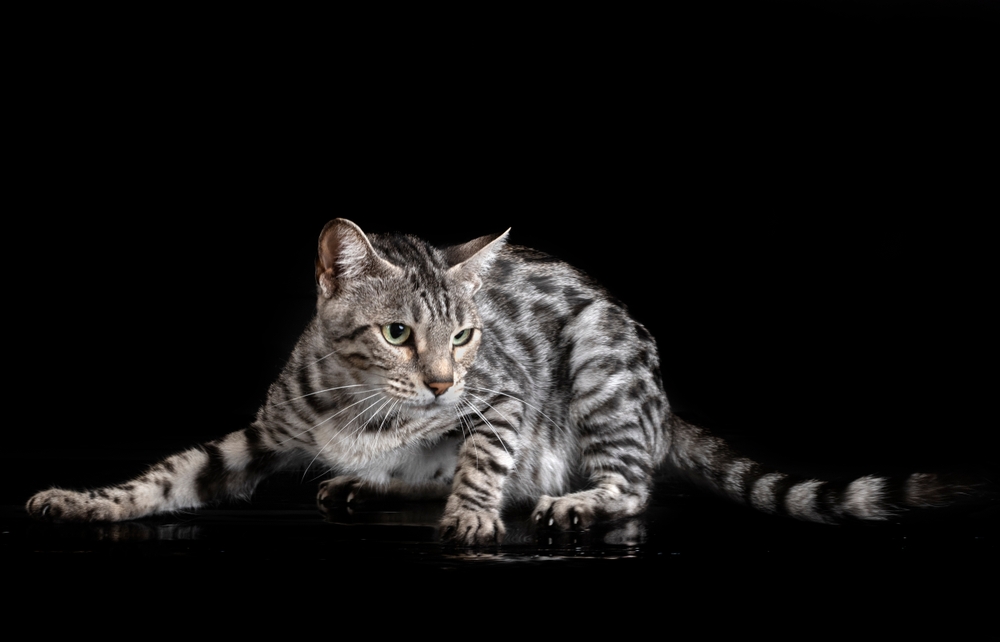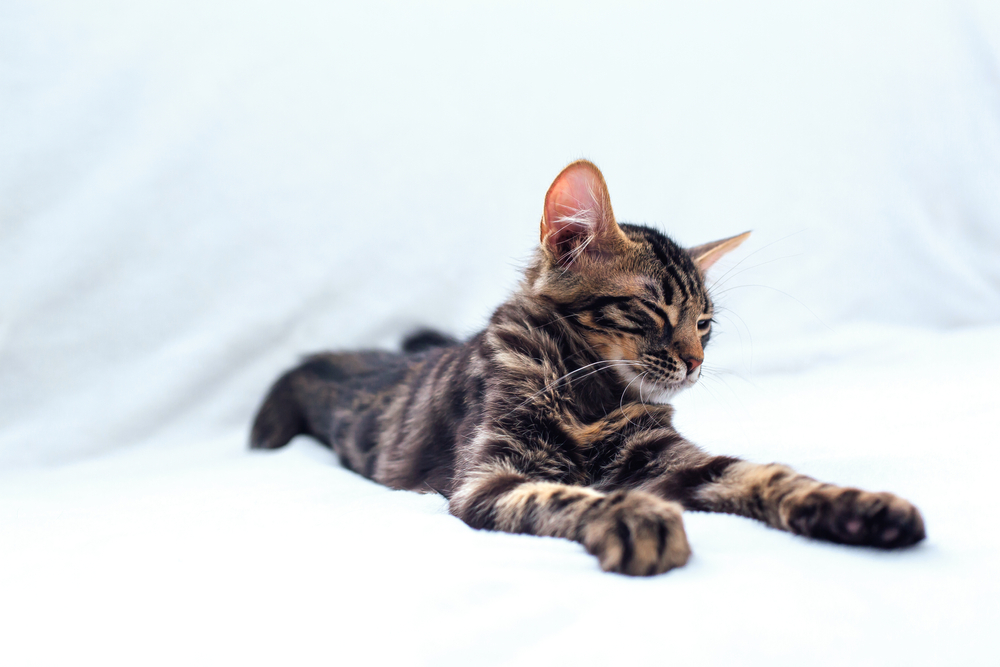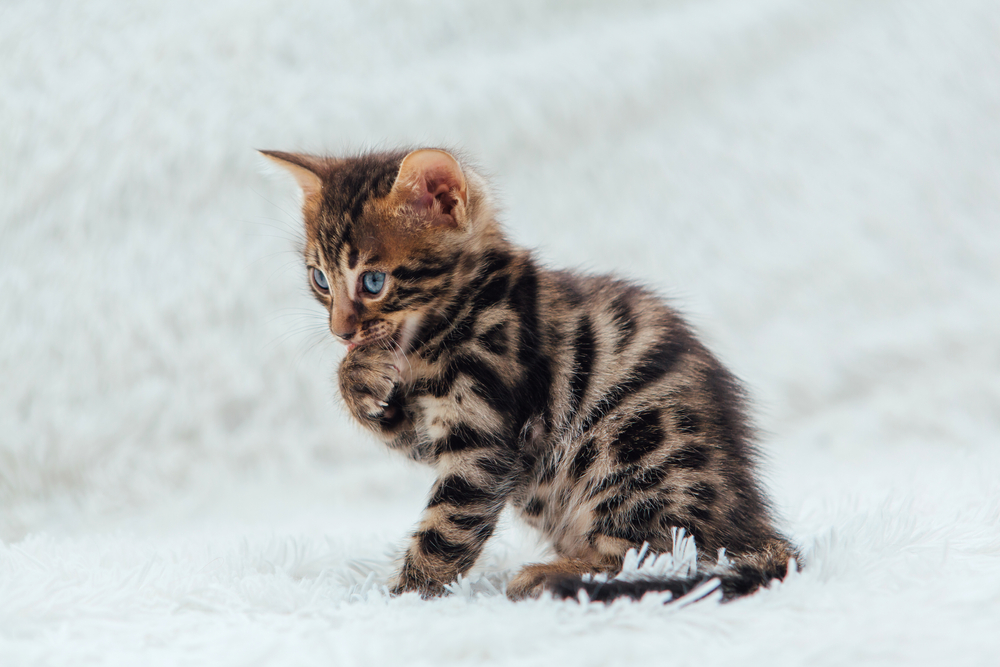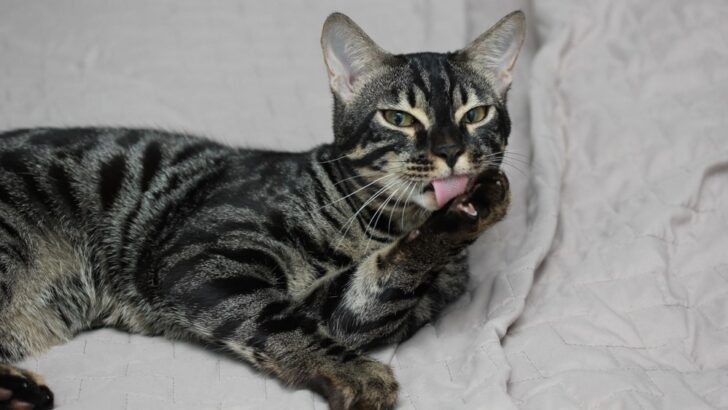On the lookout for an affectionate, appreciative feline that prefers to run around and scare the neighbors rather than nap on the ground and do nothing? Oh, you’re guaranteed to take a step back every time you see a charcoal Bengal cat roaming around your apartment.
What’s a Bengal cat, you wonder? We’ve got you covered.
Bengal cats are the closest you can get to owning a little leopard without having to commit a felony – sort of. Bengals are a hybrid breed descended from domestic cats and Asian leopard cats that have been removed from their original wild parents for a number of generations.
With spotted or marbled, dense, short coats, these bad beauties resemble ocelots, margays, and clouded leopards. Whether you’ve always dreamt of owning a wild cat or you’re taken aback by the beauty of a Bengal cat, you’re guaranteed to be smitten by a charcoal Bengal even more.
What’s a charcoal Bengal? What makes a charcoal Bengal – well, charcoal? More on that down below!
What’s a charcoal Bengal?

Charcoal Bengal cats are what dreams are made of, and here’s why. Contrary to what a Bengal cat’s physique might say, they’re the sweetest, cutest, cuddliest creatures out there and they’re more than happy to hang out with humans.
Wild, perceptive, and agile, Bengals aren’t strangers to roaming around the apartment, sniffing out potential prey, and trying to escape through the window. But that’s not to say they’re difficult to work with – they’re simply a little more energetic than your average moggy.
Bengal cats, charcoal or otherwise, are terrific companions that have had enough time on earth to know how to behave. Although crosses between domestic cats and Asian leopard cats occurred as early as the 1800s, a breeder by the name of Jean Mill was the first to successfully breed a Bengal cat in 1963.
Bengals were only accepted by the Cat Fanciers’ Association in 1996 because of the controversy over how wild these bad beauties actually are. As for the charcoal Bengal cat, the specific color of the breed seems to have not been accepted by the Cat Fanciers’ Association or the International Cat Association yet.
Brown, silver, and snow are the three colors that have been accepted as standard or representative of a purebred Bengal. Charcoal, blue, and black haven’t.
Charcoal Bengal cats are defined by boldly patterned short, stubby coats with darker faces and darker stripes scattered across the body. And, to make matters more scientific, the charcoal pattern is produced by the combination of a domestic cat non-agouti variant and an Asian Leopard Cat agouti variant.
At the end of the day, though, charcoal Bengal cats are a sight for sore eyes. And we’re more than happy to talk about them a little more!
What to know about a charcoal Bengal cat before getting one
1. Charcoal Bengal cats are the epitome of “large and in charge”

Bengals might not be as big as Maine Coons, but they’re muscular, strong, and athletic. With most Bengals reaching a healthy height of 8 to 10 inches and a considerable weight of 8 to 15 pounds, it’s safe to say these precious pets are guaranteed to make for an arm workout.
Whether you were planning on getting a large animal from the get-go or you had your heart set on a charcoal Bengal you saw at the shelter, we recommend you take your time before taking the leap. Bengals are big cats with big personalities and you might not be ready for “all that jelly.”
2. Bengal cats come from a wild background
Charcoal Bengals look wild, but are they actually wild? We’ve already brushed over the fact that the Bengal breed was achieved by pairing a domestic cat and a small Asian leopard cat.
With their signature spotted appearance, charcoal Bengal cats are the best of both worlds – they’re affectionate, appreciative, and sweet, but they’re intimidating at the same time.
Bengal cats are considered wild by many, and you might need to go through thick and thin to get your hands on one of these curious creatures.
3. Bengals are defined by generation
Why are charcoal Bengals deemed wild even though they’ve been domesticated for years and years, though? Bengal cats are classified by how many generations they are removed from their original wild parent.
Considering they’re born to Asian leopard cats that require permits and are subject to strict regulations, there’s a procedure that Bengal cats need to go through to be considered domesticated and safe.
A kitten born to an Asian leopard cat is called an F1. And every following generation is progressively called an F2, F3, etc. Asian leopard kittens (F1s) are generationally too close to their wild ancestors, but kittens born several generations later aren’t.
Charcoal Bengal cats need to be called at least an F4 to be considered safely domesticated.
4. Charcoal Bengals are super rare

Compared to the rest of the Bengal cat colors, charcoal Bengals are considered super rare.
Charcoal is a result of the ALC agouti gene (Apb) combined with the domestic cat non-agouti gene (a). When you decide to get a Bengal cat, you might have a hard time finding one with a dark mask and dark stripes scattered across the body.
Because of that, you might need to break the bank, too. Charcoal Bengal kittens can cost up to $2,500, depending on the breeder. But need we say that they’re worth the money!
5. Bengals are natural hunters
We’re aware that all cats are hunters, but charcoal Bengals are much more skilled than the average cat – they’re able to spot, chase, and catch a mouse from miles away.
But mice aren’t even what tickles a Bengal’s fancy. Bengal cats are obsessed with hunting fish, and they’re more than happy to get wet for the sake of getting what they want.
Aquarium owners might want to watch out, that’s for sure. And people with smaller pets such as hamsters, guinea pigs, and bunnies might want to pass on the opportunity to house this charcoal huntsmen. Better safe than sorry, right?
6. Bengals adore water
Cats are notorious for fleeing the moment any water touches them, but these charcoal creatures are different. They’re fond of water and more than likely to spend hours and hours playing with water.
Wet fur might not be comfortable for fluffy cats such as Maine Coons or Ragdolls, but a Bengal’s short and dense coat allows them to dry quicker.
When you become a parent to a Bengal cat, you’ll get used to her pawing at the glass of water you left unattended or sneaking into the shower when you’re busy putting shampoo in your hair. Motion-sensitive faucets and pet fountains are a must when you’re a Bengal parent.
7. Charcoal Bengal cats have “glittery” fur

Bengals are blessed with coats that attract attention, whether they’re marbled or spotted, charcoal or silver, glittery or not glittery. Before you freak out over the possibility of owning a glittery cat, know that not every Bengal cat comes with the ability to glitter.
When exposed to direct sunlight, certain Bengals appear to have an iridescent sheen. Because they’re darker than silver or snow Bengals, charcoal Bengals look like they’ve been dusted with golden or silver pixie dust.
The shimmer effect is caused by hollow hairs that catch and reflect the light at certain angles. Bengals are one of the rare breeds that have the ability to sparkle.
8. Bengal cats adore playing with dog toys, walking on a leash, and playing fetch
Pet parents who prefer snuggling on the sofa with a fluffy friend sleeping right beside them might not be the right pick for a charcoal Bengal. Bengals are friendly, fun, and energetic, and they’re more than happy to snuggle with you – when they’re done turning the entire apartment upside down.
With Bengal kitties, you’re guaranteed to never get bored. They’re obsessed with dog toys, walking on a leash, and playing fetch. No wonder they’re often described as doglike.
9. Bengals are illegal in certain countries
We might have blown your socks off with that sentence, but that’s the truth – Bengal cats, charcoal or otherwise, are illegal in several spots in the world. Bengal ownership, for example, is illegal in Hawaii and New York City.
Seattle and Denver aren’t as strict about owning Bengals, but they’ve implemented strict restrictions and regulations that prevent you from owning a wild animal. Bengal generations from F1 to F4 are monitored in several states, too.
Before you say yes to the Bengal, check with the local laws on ownership of the breed to ensure you’re allowed to do so.
10. Two Bengals are better than one

A charcoal Bengal cat might not be everyone’s cup of tea – you shouldn’t get a Bengal cat because you saw your favorite celebrity’s got one or you thought she’d make for great TikTok content.
Additionally, Bengals aren’t solitary creatures, which means you very well may end up getting another one even though you’re not ready to own one, let alone two Bengal cats. If you’re ready to welcome a one-of-a-kind kitto into your family, though, it doesn’t get better than a charcoal Bengal.
